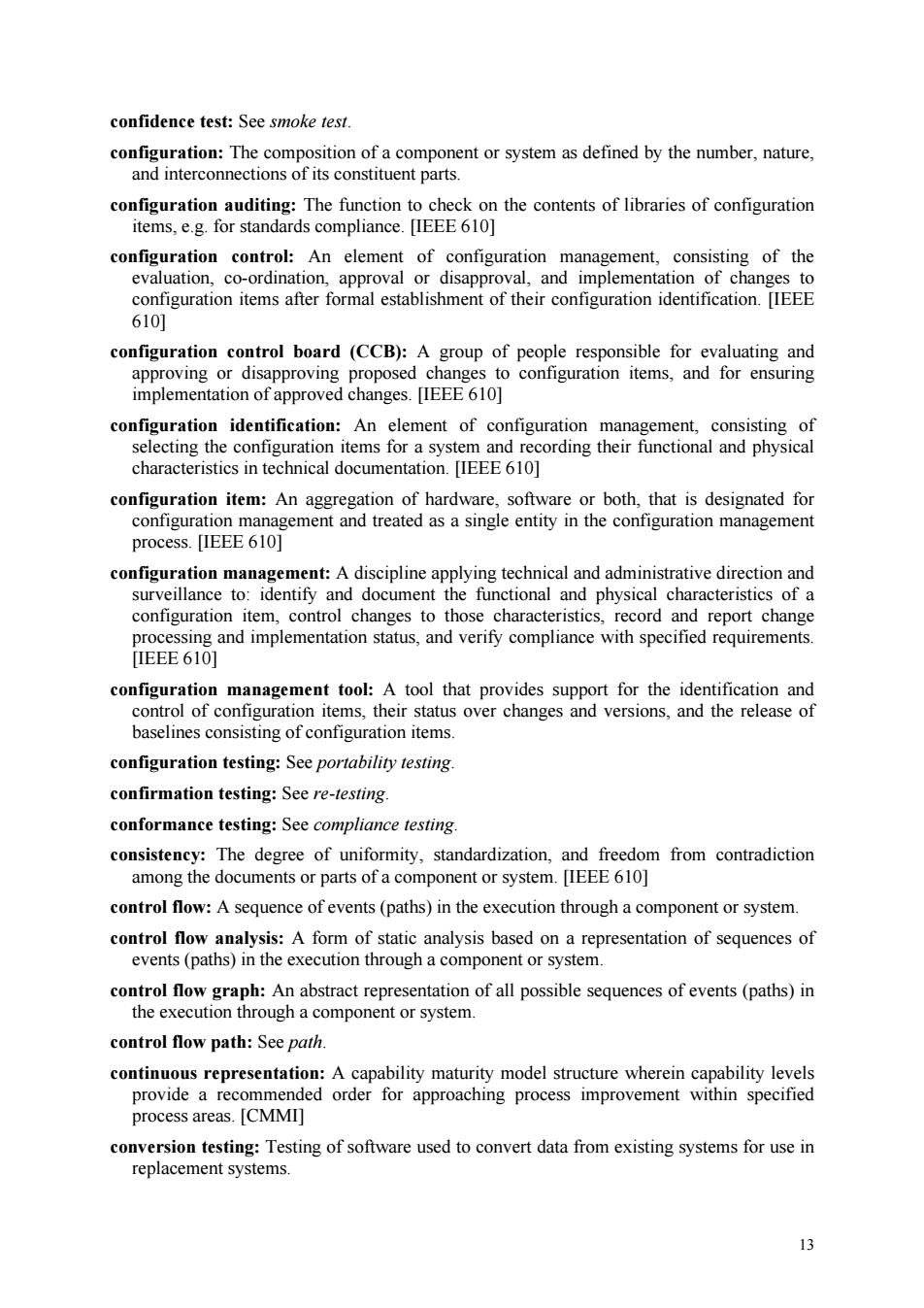正在加载图片...

confidence test:See smoke test. configuration auditing:The function to check on the contents of libraries of configuration items,e.g.for standards compliance.[EEE610] configuration control:An element of configuration management,consisting of the evaluation,co-ordination,approval or disapproval,and implementation of changes to configuration items after formal establishment of their configuration identification.[IEEE 6101 configuration control board (CCB):A group of people responsible for luating and o configuration items,and Tor ensuring configuration identification:An element of configuration mana ment consisting of characteristics in technical documentation.[IEEE 610] configuration item:An aggregation of hardware,software or both,that is designated for configuration management and treated as a single entity in the configuration management process.IEEE 610 ative dire ance ion and ntrol c function physic acteris ing and impleme ntation status and verify iance with [IEEE 6101 configuration management tool:A tool that provides support for the identification and control of configuration items,their status over changes and versions,and the release of baselines consisting of configuration items. configuration testing:See portability testing. confirmation testing:See re-testing conformance testing:See compliance testing consistency:The degree of uniformity,standardization,and freedom from contradiction among the documents or parts of a component or system.[IEEE 610] control flow:A sequence of events(paths)in the execution through a component or system. control flow control flow graph:An abstract representation of all possible sequences of events(paths)in the execution through a component or system. control flow path:See path. continuous representatio ility maturity model structure wherein capability leve provide a conversion testing:Testing of software used to convert data from existing systems for use in replacement systems. 3 13 confidence test: See smoke test. configuration: The composition of a component or system as defined by the number, nature, and interconnections of its constituent parts. configuration auditing: The function to check on the contents of libraries of configuration items, e.g. for standards compliance. [IEEE 610] configuration control: An element of configuration management, consisting of the evaluation, co-ordination, approval or disapproval, and implementation of changes to configuration items after formal establishment of their configuration identification. [IEEE 610] configuration control board (CCB): A group of people responsible for evaluating and approving or disapproving proposed changes to configuration items, and for ensuring implementation of approved changes. [IEEE 610] configuration identification: An element of configuration management, consisting of selecting the configuration items for a system and recording their functional and physical characteristics in technical documentation. [IEEE 610] configuration item: An aggregation of hardware, software or both, that is designated for configuration management and treated as a single entity in the configuration management process. [IEEE 610] configuration management: A discipline applying technical and administrative direction and surveillance to: identify and document the functional and physical characteristics of a configuration item, control changes to those characteristics, record and report change processing and implementation status, and verify compliance with specified requirements. [IEEE 610] configuration management tool: A tool that provides support for the identification and control of configuration items, their status over changes and versions, and the release of baselines consisting of configuration items. configuration testing: See portability testing. confirmation testing: See re-testing. conformance testing: See compliance testing. consistency: The degree of uniformity, standardization, and freedom from contradiction among the documents or parts of a component or system. [IEEE 610] control flow: A sequence of events (paths) in the execution through a component or system. control flow analysis: A form of static analysis based on a representation of sequences of events (paths) in the execution through a component or system. control flow graph: An abstract representation of all possible sequences of events (paths) in the execution through a component or system. control flow path: See path. continuous representation: A capability maturity model structure wherein capability levels provide a recommended order for approaching process improvement within specified process areas. [CMMI] conversion testing: Testing of software used to convert data from existing systems for use in replacement systems